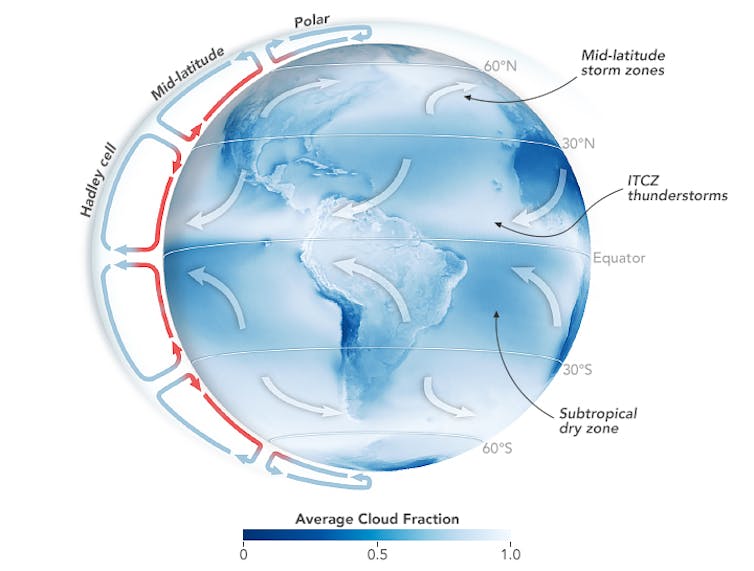
- Two-thirds of Earth's surface is covered by clouds that cool the planet by reflecting sunlight
- Highly reflective cloud areas near the equator and storm tracks are shrinking due to warming
- Less reflective broken cloud areas in the subtropical trade-wind regions are expanding
At any given time, about two-thirds of Earth's surface is covered by clouds. Overall, they make the planet much cooler than it would be without them.
But as Earth gets warmer, mostly due to the rise in greenhouse gases in the atmosphere from humans burning fossil fuels, clouds are changing too. And that might already be causing more warming – adding to the greenhouse heat boost, and changing clouds even more.
Over the past few years, the world's average temperature has increased more than climate scientists were expecting. In our latest research, led by NASA Goddard Institute for Space Studies, we show that changes in clouds have made a significant contribution to turning up the thermostat.
Clouds And Climate
Clouds help to keep Earth cool by reflecting sunlight back out to space before it can reach the ground. But not all clouds are equal.
Shiny, white clouds reflect away more sunlight – especially when they are closer to the equator, in the parts of Earth that receive the most sun. Grey, broken clouds reflect less sunlight, as do clouds closer to the poles where less light falls.
Research published last year showed that Earth has been absorbing more sunlight than the greenhouse effect alone can explain. Clouds were involved, but it wasn't clear exactly how.
Bright Cloud Zones Are Shrinking
Our new study shows what is happening. The areas covered by highly reflective clouds are shrinking. At the same time, the areas containing broken, less reflective clouds are growing.
The net effect is that additional energy from sunlight is reaching Earth's surface. Here it is absorbed, leading to extra heating.
We also looked at the effect of changes in the properties of the highly reflective clouds, caused by things such as changes in the amount of aerosol pollution in the atmosphere. However, we found these effects are much smaller than the effect of the change in area.
The Global Picture
In the big picture, Earth's wind patterns are driven by hot air rising near the equator and the rotation of the planet. This creates huge, looping currents of atmospheric circulation around the globe.
Local weather systems – the kind that determine the location and type of clouds – depend on these major, large-scale wind systems. The major circulation patterns in the atmosphere are changing as a result of global warming.
We found much of the cloud action is taking place at the edges of these major wind systems.

Highly reflective clouds are on the decline in a region near the equator called the intertropical convergence zone, and also two other bands called the storm tracks, which lie between 30 and 40 degrees of latitude.
At the same time the subtropical trade-wind regions, home to ever-present but less reflective broken clouds, are expanding.
A Feedback Loop
In short, the global warming induced by increased greenhouse gases changes the major wind systems on Earth. This in turn reduces the area of highly reflective clouds, leading to additional warming.
Warming changes wind patterns, which changes cloud patterns, which results in more warming. This is what we call a “positive feedback” in the climate system: warming leads to more warming.
We still have a lot to learn about the details of this feedback loop. Our research will use ongoing satellite-based observations of clouds and how much energy Earth receives and radiates back out to space.![]()
(Author: Christian Jakob, Director, ARC Centre of Excellence for the Weather of the 21st Century, Monash University)
(Disclosure Statement: Christian Jakob receives funding from the Australian Research Council.)
This article is republished from The Conversation under a Creative Commons license. Read the original article.
(This story has not been edited by NDTV staff and is auto-generated from a syndicated feed.)
Track Latest News Live on NDTV.com and get news updates from India and around the world

